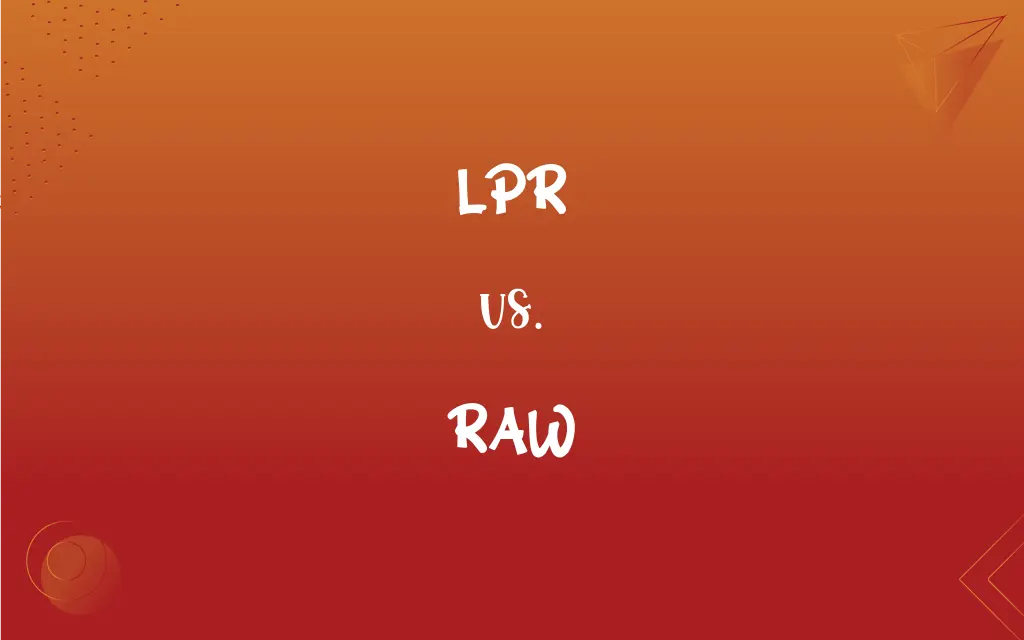LPR vs. RAW: What's the Difference?
Edited by Aimie Carlson || By Janet White || Published on February 7, 2024
LPR (Line Printer Remote) is a protocol used to submit print jobs to a network printer. RAW is a printing protocol that sends data to a printer without any modifications.

Key Differences
LPR, or Line Printer Remote, is a standard protocol for submitting print jobs to network printers, providing a queue-based print service. RAW, in contrast, refers to a printing protocol where data is sent to a printer without processing or interpretation.
LPR includes mechanisms for print job management, like queue handling and job prioritization. RAW printing sends data directly to the printer, bypassing these management features.
LPR is widely used in network printing environments for its compatibility and control features. RAW protocol is commonly used for applications requiring direct communication with the printer.
LPR allows for better management of multiple print jobs in a network. RAW protocol is often chosen for faster printing as it requires less processing.
The LPR protocol can support advanced printing features depending on the printer. RAW printing is generally more basic and doesn't support advanced features.
ADVERTISEMENT
Comparison Chart
Protocol Function
Submits print jobs with queue management
Sends data directly to printer
Job Management
Includes job prioritization and control
Lacks print job management
Usage Environment
Common in networked, multi-user settings
Used for direct printer communication
Processing Requirement
Requires processing at the printer level
Minimal to no processing
Support for Advanced Features
Can support advanced printing options
Generally basic functionality
ADVERTISEMENT
LPR and RAW Definitions
LPR
A protocol for network printer job submission and management.
The office printer uses LPR for efficient job queuing.
RAW
RAW bypasses additional processing for faster output.
RAW is great for quick, straightforward print tasks.
LPR
LPR facilitates print job prioritization in network environments.
With LPR, urgent documents are prioritized in the print queue.
RAW
Often used when direct printer communication is needed.
Our graphic design software prints directly using RAW.
LPR
A standard protocol in many business and academic settings.
Our university's printers all operate on the LPR protocol.
RAW
Suitable for applications with pre-formatted data.
RAW protocol works best for our pre-designed flyers.
LPR
LPR allows for detailed control over print jobs.
We use LPR to manage and organize our printing needs.
RAW
A protocol for sending unprocessed data to printers.
We use RAW printing for jobs that require no formatting.
LPR
Supports multiple users and complex print tasks.
LPR is ideal for our large office with many users.
RAW
Lacks advanced job management features.
RAW printing doesn't allow us to prioritize print jobs.
RAW
Uncooked
Raw meat.
RAW
Being in a natural condition; not processed or refined
Raw wool.
FAQs
What is LPR primarily used for?
LPR is used for submitting and managing print jobs in network environments.
Can LPR handle multiple print jobs simultaneously?
Yes, LPR can manage multiple print jobs with its queue system.
Does LPR support advanced printer features?
Yes, LPR can support advanced printer features depending on the printer.
What kind of data does RAW protocol handle?
RAW protocol handles data that is sent directly to the printer without modification.
Can RAW protocol be used for complex printing tasks?
RAW is less suitable for complex tasks as it lacks advanced management features.
Can LPR be used for remote printing?
Yes, LPR is well-suited for remote printing in network setups.
Can RAW printing be used in a network setting?
RAW can be used in network settings but lacks the advanced management of LPR.
Is setup for RAW printing complex?
RAW printing setup is generally straightforward but depends on the printer and application.
Is LPR suitable for home use?
LPR can be used at home but is more common in office or networked environments.
Is RAW printing faster than LPR?
Generally, RAW printing can be faster as it involves less processing.
Is LPR compatible with all network printers?
Most network printers support LPR, but compatibility should be confirmed.
How does LPR affect printer efficiency?
LPR can enhance efficiency by managing and organizing print jobs effectively.
Does LPR allow for print job prioritization?
Yes, LPR includes mechanisms for prioritizing print jobs.
Does RAW require specific printer drivers?
RAW printing typically requires compatible printer drivers.
Are there security concerns with using LPR?
Like any network protocol, LPR should be configured with security in mind.
What environments commonly use RAW printing?
RAW is often used in environments needing direct and quick printer communication.
Can RAW be used for high-quality print tasks?
RAW can be used for high-quality tasks if the data is pre-formatted correctly.
Does RAW support printing from mobile devices?
This depends on the mobile device and printer compatibility.
Can LPR handle large print jobs effectively?
Yes, LPR is designed to handle large and multiple print jobs efficiently.
Is user intervention required in RAW printing?
RAW printing typically requires minimal user intervention once set up.
About Author
Written by
Janet WhiteJanet White has been an esteemed writer and blogger for Difference Wiki. Holding a Master's degree in Science and Medical Journalism from the prestigious Boston University, she has consistently demonstrated her expertise and passion for her field. When she's not immersed in her work, Janet relishes her time exercising, delving into a good book, and cherishing moments with friends and family.
Edited by
Aimie CarlsonAimie Carlson, holding a master's degree in English literature, is a fervent English language enthusiast. She lends her writing talents to Difference Wiki, a prominent website that specializes in comparisons, offering readers insightful analyses that both captivate and inform.







































































